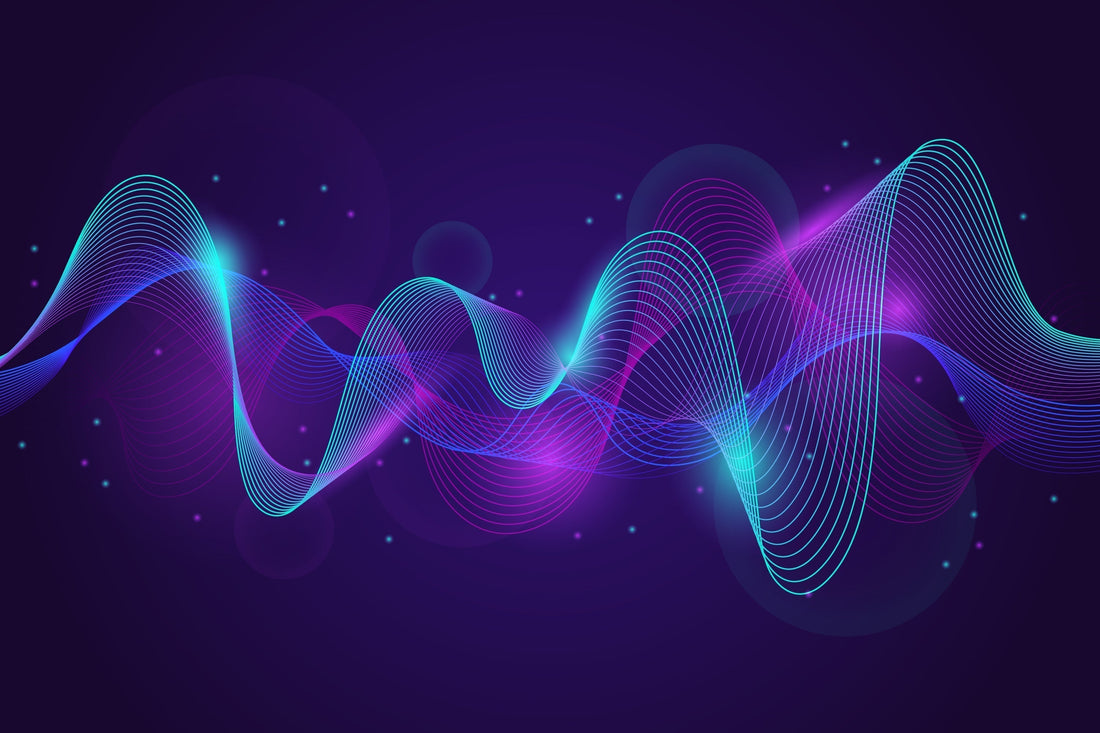
The Symphony of Frequencies: How Vibrations Connect Biology, Crystals, and Energy Fields
Share
Introduction: Living in a Vibrational Universe
From the steady beat of our hearts to the frequencies of crystals deep within the Earth, everything vibrates. Science tells us that frequency (the rate at which something oscillates) isn’t just a physics concept. It plays a vital role in biology, emotions, and even the subtle interactions between our bodies and the environment.
What Is Frequency in Biology?
In biological terms, frequency (measured in hertz or Hz) refers to how often something occurs per second, like your heartbeat or brainwaves. One Hz equals one cycle per second. This rhythmic quality is at the core of life: our neurons fire in rhythmic patterns, our heart beats in cycles, and even our cells exhibit oscillations (Brizhik, 2010; Popp, 2003).
The Brain’s Frequency Spectrum
Our brain operates across five primary wave frequencies, each tied to mental and emotional states (Hughes, 2021; Siever, 2020):
-
Delta (0.5–4 Hz): Deep sleep, physical regeneration
-
Theta (4–8 Hz): Light sleep, meditation, creativity
-
Alpha (8–12 Hz): Relaxation, present awareness
-
Beta (12–30 Hz): Focus, logical thinking
-
Gamma (30–100 Hz): Insight, high-level cognition
These brain states can shift depending on your activity—creative flow boosts alpha waves, while solving a math problem can increase beta activity.
The Heart’s Powerful Field
While the brain is often considered the control center, the heart actually emits the body’s strongest electromagnetic field, about 60 times greater in electrical amplitude and 100 times stronger magnetically than the brain’s (McCraty, 2004). This field can be detected several feet from the body and plays a key role in emotional communication and internal regulation.
According to the HeartMath Institute, when we experience emotions like love or gratitude, our heart rhythms become coherent, meaning they synchronize with our brainwaves, hormones, and even respiration. This state, called heart coherence, has been linked to improved emotional stability and cognitive clarity (McCraty & Childre, 2010).
Fascinatingly, this coherent state resonates at approximately 0.1 Hz, a frequency that matches one of Earth’s natural electromagnetic resonances (McCraty, 2004).
Emotions and Frequency: The Inner Landscape
Dr. David R. Hawkins (2002), in Power vs. Force, proposed a scale of emotional frequencies, suggesting that our emotional states emit measurable energetic vibrations:
-
Shame: 20 Hz
-
Fear: 100 Hz
-
Love: 500 Hz
-
Peace: 600 Hz
-
Enlightenment: 700–1,000 Hz
Though these values are conceptual, HeartMath research supports the link between emotions and physiological coherence, reinforcing the idea that emotions truly affect our energy field (McCraty & Childre, 2010).
Crystals: Vibrational Allies
Crystals like quartz and selenite are prized for their vibrational consistency. Quartz, in particular, is piezoelectric, meaning it generates an electric charge when mechanically stressed, and conversely, vibrates when exposed to an electrical field (Gordon, 2015; Yang, 2006). This property is why quartz is used in watches, GPS devices, and even hospital equipment—to keep time with astonishing precision.
Each quartz crystal vibrates at a specific frequency based on its size and cut. This makes them excellent tools not just in technology, but in holistic practices that value their stable, amplifying energy.
-
Quartz: Clear, durable, and known for energy amplification
-
Selenite: Soft, luminous, and linked to cleansing and clarity (Hall, 2013)
The Science of Entrainment and Resonance
Two key principles explain how frequencies might interact within our bodies and with external sources like crystals:
-
Resonance: When a vibrating system induces another system to vibrate at the same frequency
-
Entrainment: When two oscillating systems naturally sync to the same rhythm
These mechanisms are observed in nature (e.g., fireflies blinking in unison) and might underline why tuning into calming music, heart coherence practices, or even the stable frequency of a crystal, can shift our internal states (Thaut, 2005).
Biofields and Energy Medicine
Emerging disciplines like biofield science and energy medicine explore the body's energetic blueprint. While not fully embraced by mainstream medicine, this field investigates the electromagnetic and subtle energy fields surrounding the human body.
Research into biophoton emissions—ultra-weak light emitted from cells—suggests that cells may communicate via light and frequency (Popp, 2003). Though subtle, these frequencies might be influenced by external energies, such as those from crystals, people, or environmental EMFs.
Animals and Frequency Sensitivity
Animals often exhibit acute sensitivity to electromagnetic fields (EMFs). Studies show that EMF exposure can disrupt bird navigation, alter melatonin levels, and affect immune function in wildlife (Balmori, 2009; Grigoriev, 2003).
Some pet owners and researchers also observe heightened sensitivity in animals to subtle energetic changes, such as when exposed to crystals or emotional shifts in their humans. While anecdotal, this aligns with broader evidence of frequency perception in the animal kingdom.
A Balanced View: Bridging Science and Intuition
While some frequency-based therapies remain controversial or under-researched, there's no denying that we are rhythmic, vibrating beings living in a world of vibration. Quartz watches, heart coherence studies, and biophoton emissions are concrete scientific phenomena. At the same time, holistic traditions offer metaphors and insights that resonate with lived human experience.
Crystals—like clear quartz, rose quartz, amethyst, and selenite—might not "heal" in a medical sense, but their stable frequencies may support emotional regulation and energetic balance through entrainment, especially when combined with mindful intention.
Conclusion: Tuning into Life’s Frequencies
As science continues to explore the invisible forces that shape our health and consciousness, frequency stands out as a powerful common thread. Whether it's the gentle hum of a crystal, the rhythm of our breath, or the pulse of the planet itself, recognizing these vibrations invites us to live more consciously, more harmoniously, and perhaps, more coherently.
Read More:
Sound And Its Healing Properties
What is Quartz Crystal and how is it used?
References
Balmori, A. (2009). Electromagnetic pollution from phone masts. Pathophysiology, 16(2-3), 191–199. https://doi.org/10.1016/j.pathophys.2009.01.007
Brizhik, L. (2010). The role of solitons in the information transfer in biological systems. Journal of Biological Physics, 36(1), 47–61. https://doi.org/10.1007/s10867-009-9162-1
Gordon, J. E. (2015). The new science of strong materials: Or why you don't fall through the floor. Princeton University Press.
Grigoriev, Y. G. (2003). Biological effects of mobile phone electromagnetic field on chick embryo (risk assessment using the mortality rate). Radiation Biology. Radioecology, 43(5), 541–543.
Hall, J. (2013). The crystal Bible. Godsfield Press.
Hawkins, D. R. (2002). Power vs. force: The hidden determinants of human behavior. Hay House, Inc.
Hughes, J. R. (2021). Responses of the brain to music and healing: A review. Clinical EEG and Neuroscience, 52(3), 169–179. https://doi.org/10.1177/1550059420963969
McCraty, R. (2004). The energetic heart: Bioelectromagnetic interactions within and between people. HeartMath Institute.
McCraty, R., & Childre, D. (2010). Coherence: Bridging personal, social, and global health. Alternative Therapies in Health and Medicine, 16(4), 10–24.
Popp, F. A. (2003). Biophotons—background, experimental results, theoretical approach and applications. Research in Complementary Medicine, 10(1), 22–29. https://doi.org/10.1159/000069970
Siever, D. (2020). The role of brainwave entrainment in psychiatry. The Journal of Neuropsychiatry and Clinical Neurosciences, 32(3), 263–269. https://doi.org/10.1176/appi.neuropsych.19110220
Thaut, M. H. (2005). Rhythm, music, and the brain: Scientific foundations and clinical applications. Routledge.
Yang, J. J. (2006). Piezoelectricity. In M. G. Norton (Ed.), Encyclopedia of Materials: Science and Technology (pp. 1–5). Elsevier. https://doi.org/10.1016/B0-08-043152-6/01444-2

